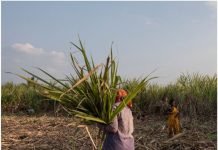Jigsaw Puzzle
The sugar futures market in NY continues trying to stay above 20 cents per pound restlessly, but keeps facing huge pushback from the imposing reality. And it goes by the name of balanced supply and demand. Whenever the market in NY goes beyond the barrier of 20 cents per pound, a large volume of price fixing coming from Asia pushes the quotations back to more realistic levels.
The May/2022 contract closed out the week made shorter by the Easter holiday at 20.13 cents per pound, a 28-point drop (a little more than 6 dollars per ton) against last week’s closing. July/2022 dropped 19 points (4 dollars per ton) closing out at 20.28 cents per pound and October/2022 was pretty much unchanged. That is, the week’s movement showed a weakening of the spreads.
That doesn’t mean, of course, that sugar prices cannot continue going up because, as we pointed out in our last comment, most commodities traded at exchanges is inverted, not because of a possible mismatch in the product supply, but mainly because end consumers fear that there is some obstacle that will get in the way of the free movement of the product. And, in turbulent settings, as we know, the funds add on new purchases seeking to profit out of the volatility increase. Then, all the curve moves upward on shorter maturities (where the momentary distress is at) fed by the adjustment of the books of the trading houses through spreads.
The 2022/2023 crop that is starting in the Center-South, as far as sugar goes, in our opinion, has been addressed. High volume of fixations (above 20 million tons of sugar) that should convert into physical export of the product because there are contracts backing these hedges. Sugar migration to hydrous production, though in small proportion, cannot be ruled out by means of washout, a condition laid down in most international contracts of commodities. In it, the seller negotiates the repurchase of the product he cannot or doesn’t want to deliver. The start of the crop decreases this possibility, but it’s worth keeping a close watch.
The average price the mills got for the fixation of export sugar of the recently-closed 2021/2022 crop was R$1,640 per ton, which updated for today’s values reaches R$1,872 per ton. When the fixations were made, the mills couldn’t predict that the production cost would increase as much as it did and part of the margin they expected to receive was eaten away by the increase in inputs.
This realization by the mills caused a slowdown in the fixations of sugar sales for the next crop (the one that is starting), which even so starts with a pretty high fixed percentage – about 80%, which is lower than the 86% of the 2021/2022 crop when it started. However, if we take the 2016/2017 crop until the 2020/2021 crop, the average percentage of fixed sugar before the start of each one was 52%. We don’t have the percentage of the next crop, but we estimate that at the end of February/2022, for example, 14% of the 2021/2024 crop which starts in April next year had already been fixed.
What caused the increase by the mills in sugar pricing last year? First, because sugar was then the only product they could hedge, which didn’t suffer any government interference via administered gas prices causing the flattening or destruction of the hydrous profit margin. Today, the mills know they can change the mix, take for granted that Petrobras has a smaller chance of suffering government interventions and, therefore, more ways to administer its production directing it to the product that provides more financial return.
When they were on a tight rope, without any hedging alternatives for a significant percentage of their production, some mills ended up using derivative products which instead of mitigating the risk, ran away from their original objective and ended up maximizing it. There are many mills and companies in the sector that got burned using exotic options last decade – accumulators, double knock-in, knock-out options, among other wonders of financial engineering. Some are still paying the bill today.
Once the 2022/2023 scenario has been laid out, what could happen to 2023/2024? The mills surveyed admit that it’s still too early to talk about the next crop. And this is a very important point.
Uncertainties pile up given the fragmentation that the decision-making process is showing. Gone are the days when the mill looked at sugar in NY and the exchange rate. Try to list the assets that make up all the cost structure and/or are part of the sugar and ethanol pricing today. It’s not a job for newbies. Those who treat the market amateurishly will be swallowed up by those who do their homework. That talk about “we have always done it like that” can be an epitaph, not a philosophy.
With so many uncertainties on the table and the concern over the production cost of this crop starting with 80% of fixed sugar at an average price of R$2,178 vis-à-vis a production cost of the previous crop of R$1,590 (January 31 base), it’s only natural that 2023/2024 is put on hold until all the fragments make up a clearer picture.
As we have said in previous comments, 2023/2024 will be a different game. We see more factors ahead that can increase the prices in cents per pound than the other way around. Most mills we have spoken to are worried about the area loss for other more advantageous crops. One of the groups registers a yearly area loss of 3% over the last five years. Recently-published UNICA data point to a drop of 1.4% in sugarcane area. No wonder that with soybean at R$180 and sugarcane at R$130, the suppliers are migrating to oilseeds.
Meanwhile, hydrous traded equivalent to sugar in NY over the week plus 300 points, if we consider a head start of about 50 points provided by CBio. Who could have seen it coming?
To read the previous episodes of World Sugar Market – Weekly Comment, click here
To get in touch with Mr. Arnaldo, write on arnaldo@archerconsulting.com.br












